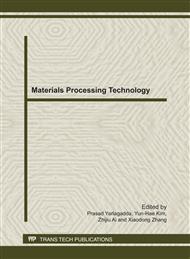[1]
Sheppard. S.D, and N. Pan: A look at fatigue is resistance spot weld notch or crack? SAE Technical Paper No. 2001-01-0433. (2001).
DOI: 10.4271/2001-01-0433
Google Scholar
[2]
Zhang. S. Recent developments in analysis and testing of spot welds. SAE Technical Paper No. 2001-01-0432. (2001)
DOI: 10.4271/2001-01-0432
Google Scholar
[3]
Ewing. K.W, M. Cheresh, R. Thompson and P. Kukuchek. Static and impact strengths of spot welded HSLA and low carbon steel joints. SAE Technical Paper No. 820281. (1982)
DOI: 10.4271/820281
Google Scholar
[4]
Zhang. Y, and D. Toylor. Sheet thickness effect of spot welds based on crack propagation. Eng. Fract. Mech, 67(2000), pp.55-63.
DOI: 10.1016/s0013-7944(00)00029-1
Google Scholar
[5]
Pan. N, and S.D. Sheppard. Stress intensity factors in spot welds. Eng. Fract. Mech. 70(2003), pp.671-684.
Google Scholar
[6]
Radaj. D. Local Fatigue Strength Characteristic Values for Spot Welded Joints. Engineering Fracture Mechanics, Vol. 37, No. 1(1993), pp.245-250.
DOI: 10.1016/0013-7944(90)90347-j
Google Scholar
[7]
Rupp. A, Störzel. K and Grubisic. V. Computer Aided Dimensioning of Spot-Welded Automotive Structures. SAE Technical Paper 950711, (1995).
DOI: 10.4271/950711
Google Scholar
[8]
Sheppard SD. Further refinement of a methodology for fatigue life estimation in resistance spot weld connections. Advances in fatigue lifetime predictive techniques, 1996(3):265–82
DOI: 10.1520/stp16142s
Google Scholar
[9]
Pan N. Fatigue life study of spot welds. Ph.D. thesis. Stanford (CA): Stanford University, 2000.
Google Scholar
[10]
Lin, P.C., S.H. Lin and J. Pan, 2006. Modeling of failure near spot welds in lap-shear specimens based on a plane stress rigid inclusion analysis. Engng. Fract. Mech., 73(15), pp.2229-2249.
DOI: 10.1016/j.engfracmech.2006.03.017
Google Scholar
[11]
Kang, H.A. 2005. A fatigue damage parameter of spot welded joints under proportional loading. Int. J. Auto. Tech., 6(3), pp.285-291.
Google Scholar
[12]
Mori N, Amago T, Ono M, Sasanabe M, Hiraide T. Fatigue life prediction methods for spot welds in T-shaped members under bending. SAE technical paper no. 860604,1986.
DOI: 10.4271/860604
Google Scholar
[13]
Peter Heyes, and Mikael Fermér. A Spot-weld Fatigue Analysis Module in the Msc/Fatigue Environment. Chinese Mechanical Engineering, Vol. 9, No. 11(1998), p.35.
Google Scholar


